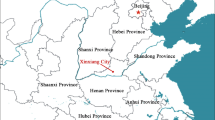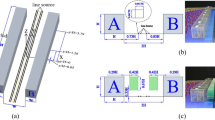Abstract
Vegetation plays a key role in improving wind environment of residential districts, and is helpful for creating a comfortable and beautiful living environment. The optimal design of vegetation for wind environment improvement in winter was investigated by carrying out field experiments in Heqingyuan residential area in Beijing, and after that, numerical simulation with SPOTE (simulation platform for outdoor thermal environment) experiments for outdoor thermal environment of vegetation was adopted for comparison. The conclusions were summarized as follows: 1) By comparing the experimental data with simulation results, it could be concluded that the wind field simulated was consistent with the actual wind field, and the flow distribution impacted by vegetation could be accurately reflected; 2) The wind velocity with vegetation was lower than that without vegetation, and the wind velocity was reduced by 46%; 3) By adjusting arrangement and types of vegetation in the regions with excessively large wind velocity, the pedestrian-level wind velocity could be obviously improved through the simulation and comparison.
Similar content being viewed by others
References
ANTROP M. Changing patterns in the urbanized countryside of Western Europe [J]. Landscape Ecology, 2000, 15: 257–270.
CAPELUTO I G, YEZIORO A, SHAVIV E. Climatic aspects in urban design-A case study [J]. Building and Environment, 2003, 38: 827–835.
GLUCH R, QUATTROCHI D A, LUVALL J C. A multi-scale approach to urban thermal analysis [J]. Remote Sensing of Environment, 2006, 104: 123–132.
RIZWAN A M, LEUNG Y C, DENNIS, LIU C. A review on the generation, determination and mitigation of Urban Heat Island [J]. Journal of Environmental Science, 2008, 20: 120–128.
ZHANG Yi-ping, ZHANG De-shang. A study about urbanization effect on the indoor and outdoor air temperature of Beijing city [J]. Climatic and Environmental Research, 2002, 09: 345–350. (in Chinese)
CHEN H, OOKA R, KATO S. Study on optimum arrangement of pilots for design of pleasant outdoor wind environment using CFD simulation and Genetic Algorithms (GA) [C]// The Sixth Asia-Pacific Conference on Wind Engineering (APCWE-VI). Seoul: 2005: 1–11.
HUANG Liang-mei, LI Jian-long, ZHAO De-hua, ZHU Ji-yu. A fieldwork study on the diurnal changes of urban microclimate in four types of ground cover and urban heat island of Nanjing, China [J]. Building and Environment, 2008, 43: 7–17.
CHEN H, OOKA R, MURAKAMI S. Study on air quality in urban area using scale for ventilation efficiency. The effect of building shape and its arrangement on ventilation efficiency in urban area [C]// Annual Technical Meetings of Architectural Institute of Japan. Tokyo, Japan: 2001: 933–934. (in Japanese)
ASHIE Y, MURAKAMMI S, MORIGAWA T, MOCHIDA A, OOKA R, OGURO M. CFD analyses on effects of wind from rivers on outdoor thermal environment: Part 2. Control of thermal environment based on building layout [C]// Annual Technical Meetings of Architectural Institute of Japan. Tokyo, Japan: 2002: 881–882. (in Japanese)
OOKA R, CHEN H, KATO S. Study on optimum arrangement of trees for design of pleasant outdoor environment using multi-objective genetic algorithm and coupled simulation of convection, radiation and conduction [J]. Journal of Wind Engineering Industrial Aerodynamics, 2008, 96: 1733–1748.
LIN T P, MATZARAKIS A, HWANG R L. Shading effect on long-term outdoor thermal comfort [J]. Building and Environment, 2010, 45: 213–221.
SHASHUA-BAR L, HOFFMAN M. Vegetation as a climatic component in the design of an urban street: An empirical model for predicting the cooling effect of urban green areas with trees [J]. Energy and Buildings, 2000, 31: 221–233.
YOSHIDA S, MURAKAMI S, OOKA R, MOCHIDA A, TOMINAGA Y. CFD prediction of thermal comfort in microscale wind climate [C]// The International Symposium on Computational Wind Engineering 2000(CWE 2000). Birmingham: 2000: 27–30.
FENG Ning, MA Jie, LIN Bo-rong, ZHU Ying-xin, Impact of landscape on wind environment in residential area [J]. Journal of Central South University of Technology, 2009, 16: 80–83.
LIN Bo-rong. Studies of greening’s effects on outdoor thermal environment [D]. Beijing: Tsinghua University, 2004. (in Chinese)
YAO Peng, HUANG Lei. Winter plant-landscape design on the residential area of Beijing [J]. Journal of Shanxi Agricultural Sciences, 2008, 36: 106–107. (in Chinese)
LIN Bo-rong, Li Xiao-feng, Zhu Ying-xin, Qin You-guo. Numerical simulation studies of the different vegetation patterns’ effect on outdoor pedestrian thermal comfort [J]. Journal of Wind Engineering and Industrial Aerodynamics, 2008, 96: 1707–1718.
LIN Bo-rong. Simulation study of the effects of plants on outdoor thermal environment [C]// Proceedings of the 2005 Simulation Academic Workshop for Chinese HVAC Specialty Boards. Beijing: 2005: 340–348. (in Chinese)
TOMINAGA Y, MOCHIDA A, YOSHIE R, KATAOKA H, NOZU T, YOSHIKAWA M, SHIRASAWA T. AIJ guidelines for practical application of CFD to pedestrian wind environment around buildings [J]. Journal of Wind Engineering and Industrial Aerodynamics, 2008, 96: 1749–1761.
SHAW R H, SEGINER I. The dissipation of turbulence in plant canopies [C]// The 7th Symposium American Meteorological Society on Turbulence and Diffusion. Boulder, 1985: 200–203.
SCHILLING V K. A parameterization for modeling the meteorological effects of tall forests-A case study of a large clearing [J]. Boundary-Layer Meteorology, 1991, 55: 283–304.
LIN Bo-rong, LI Xiao-feng. Thermal environment control and technology improvement in residential district [M]. Beijing: China Architecture and Building Press, 2010: 22–23. (in Chinese)
Author information
Authors and Affiliations
Corresponding author
Additional information
Foundation item: Project(50878111) supported by the National Natural Science Foundation of China
Rights and permissions
About this article
Cite this article
Hong, B., Lin, Br., Wang, B. et al. Optimal design of vegetation in residential district with numerical simulation and field experiment. J. Cent. South Univ. Technol. 19, 688–695 (2012). https://doi.org/10.1007/s11771-012-1058-6
Received:
Accepted:
Published:
Issue Date:
DOI: https://doi.org/10.1007/s11771-012-1058-6




